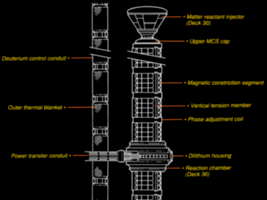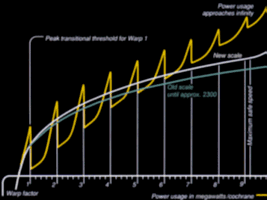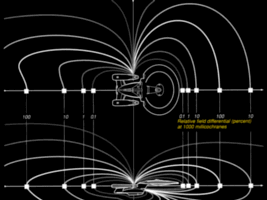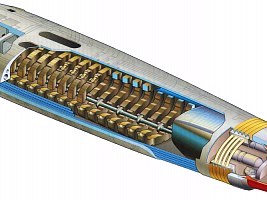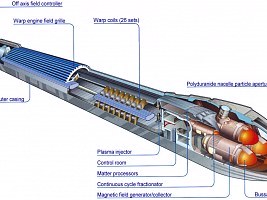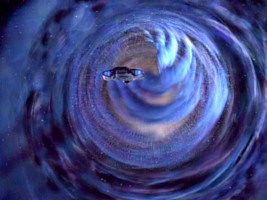Treknology Encyclopedia - W
Warning beacon Also referred to as warning buoy. Automated transmitter for a verbal message or another type of signal that warns approaching spacecrafts of a possible danger (TNG: "Identity Crisis", VOY: "Bliss", "Memorial", ENT: "Observer Effect").
The quarantine warning on the USS Lantree worked in a similar fashion, albeit without a separate beacon.
Warp barrier Limit to warp propulsion. Refers rather to the peak transitional thresholds than to Eugene's limit that only stands for the fundamental physical principle that infinite speed is impossible (generic).

Warp bomb Weapon of mass destruction based on the principle of the warp drive, developed by the inhabitants of Kiley 279 (SNW: "Strange New Worlds").
The warp drive consists of the matter/antimatter reaction (power generation) and the nacelles with the warp coils (using the power to create the warp field). I take it that the inhabitants of Kiley 279 didn't bother about the latter part, which is arguably more complex and very likely beyond their grasp anyway. Also, they wouldn't have dilithium to create a controlled reaction, or even wouldn't know they need dilithium. They were interested in an uncontrolled reaction, a matter/antimatter bomb. But the mere existence of antimatter (as e.g. in VOY: "Friendship One") would not create a "warp signature", and the weapon wouldn't be called a "warp bomb" but a photon torpedo.
Warp coil Toroid or split toroid element that generates a subspace field when energized by a modulated plasma stream. A set of several warp coils is combined in a warp nacelle. Plasma injectors serve to adjust the activation sequences of the single warp coils in a way that a propulsive warp field is formed (generic).
Concerning the technical plausibility, the warp coils are the most critical part of the propulsion system. It is not exactly defined what a warp field actually is, let alone how it can be generated. The only time we can see the warp coils of a ship is when they are being serviced in VOY: "Nightingale" (discounting the pathetic device called "warp coil" in ENT: "Damage").
Warp core Part of the warp drive in which power is generated through a controlled annihilation of matter and antimatter, also referred to as warp reactor or as matter/antimatter reaction chamber (M/ARC). The complete warp power generation system including the warp core, matter and antimatter injectors and constriction elements, is called matter/antimatter reaction assembly (M/ARA). Matter and antimatter stream are combined in the dilithium crystal inside the warp core, resulting in a (warp) plasma stream. A failure of antimatter containment is commonly referred to as warp core breach. In this case antimatter can get in contact with matter, leading to a disastrous explosion that destroys the ship. In case of a containment failure, the warp core offers the option of an emergency shutdown. If the shutdown does not work, it is possible to eject the whole M/ARA (generic).
It is a quite optimistic assumption that in case of a pending warp core breach there is enough time left to try the emergency shutdown and finally eject the M/ARA and that the remaining time can even be exactly determined. Moreover, the breach would probably be stimulated by the vibrations during the ejection. On the other hand, it is disturbing that such an extremely dangerous technology is commonplace in starships, considering that life in the 24th century is nearly free of risks. The problem of containment seems to be especially severe in Galaxy-class ships, three of which have been prematurely destroyed by warp core breaches, though they were supposed to have a lifetime of 100 years.
Warp core breach The worst possible accident to happen on a warp-driven starship. Caused by an antimatter containment failure, matter and antimatter may collide in larger quantities, leading to a chain reaction that inevitably destroys the whole ship (generic).
Warp core ejection Emergency procedure to save a starship from a pending warp core breach (VOY: "Cathexis", "Day of Honor", "Course: Oblivion", "Renaissance Man", "Star Trek: Insurrection").
Warp factor Unitless figure that represents the speed of a ship or signal traveling faster than light. In the 23rd century, the warp factor WF was calculated as follows: WF=(v/c)^1/3, where v is the speed of the signal or starship, c=3*10^8m/s the speed of light and ^1/3 denotes the cubic root. At Warp 1, a starship reaches c, at Warp 6 it reaches 216c. In the 24th century, a term was added to the above equation that caused the speed to be infinite at Warp 10 (see comparative warp speed table). The ratio v/c at a given warp factor is equal to the corresponding cochrane value that describes the subspace distortion (generic).The warp speed table was changed in accordance with Roddenberry's wish that Warp 10 should be the absolute maximum velocity (Eugene's limit). The recalibration, however, must not be mistaken as a speed limit. At Warp 9, the speed is 729c for the old and 1516c for the new scale. Above Warp 9, the two scales diverge significantly, and the old Warp 10 speed is 1000c, whereas it is infinite for the new warp table. So any speed is still possible in the new scale, only the values of 9.99... are not easy to handle for the starship crew. This might be the reason why the scale is changed again in the potential future in TNG: "All Good Things", where Warp 13 is possible. The change could also be attributed to the introduction of transwarp. While the apparent speed and the cochrane value steadily rise with the warp factor, the power expenditure exhibits remarkable peaks at each full warp factor. Explaining these peak transitional thresholds leads to a reasonable (yet conjectural) definition of the old as well as of the new warp scale.
Warp field Subspace field with a subspace distortion of at least 1 cochrane. A starship enveloped in a warp field is able to travel faster than light, without relativistic limits being violated. The warp field used by Federation starships is propulsive itself without an additional exhaustion necessary. This is accomplished by sequentially activating the warp coils (generic).A symmetrical, non-propulsive warp field is used for 24th century starship computer cores, where it allows FTL travel of electrons or photons within the field limits (TNGTM). A warp field does not seem to be much different from a subspace field, and the transition from one to the other is continuous, as is indicated by the energy vs. warp factor diagram. On his website Jason Hinson devises a more specific and more plausible definition of the warp field than canon sources. According to his theory, a warp field "couples the frame of reference of everything inside the warp field to the frame of reference of subspace. This becomes true regardless of what the frame of reference of the ship would be without the warp field there (i.e. it is true regardless of the actual speed of the ship with respect to subspace). Thus, while the warp field is active, the ship's frame of reference remains the frame of reference of subspace and is not dependent on the ships speed. This is what places the ship outside of the realm of relativity and allows it to travel faster than light without gross violations of causality." Read also my conjectural theory on subspace fields.
Warp injector See warp core, antimatter injector.
Warp matrix Part of the warp power system of a Starfleet ship from the 22nd to the 24th century (DS9: "What You Leave Behind", VOY: "Unimatrix Zero", ENT: "United", "Affliction", "Divergence").
It is not certain what warp matrix actually denotes, as the term was apparently made up without the "blessing" of the TNGTM (yes, I know that the book is not authoritative but it makes more sense than usual Treknology). But we may imagine that the matrix is either a special arrangement of the dilithium crystals inside the warp core (rather than the structure of the crystal itself that is solely a matter of manufacturing) or a certain wave pattern of excitation of the crystals.
Warp nacelle Part of the warp drive that holds the warp coils, plasma conduits and injectors, usually in a housing separate from the hull. Almost all Federation starships possess an even number of nacelles, arranged symmetrically to the longitudinal axis. While most vessels have two nacelles, a number of starships (for instance Constellation class, Cheyenne class and the USS Prometheus) are equipped with four of them. The Freedom class, on the other hand, is one of the very few ship classes with a single nacelle. Support pylons connect the nacelles to the ship's hull and supply the warp coils with plasma through power transfer conduits (PTC). Usually, a Bussard collector is attached to the front end of each warp nacelle. Romulans and Klingons use warp nacelles similar to the Federation type (generic).Ships with two warp nacelles look much better than those with only one nacelle. Yet, there is a more technical explanation for this design rule. An even number of nacelles symmetrical to the ship's centerline obviously serves for better stability and maneuverability. With such a configuration the ship's flight path can easily be changed or corrected through different firing sequences for the two sets of warp coils, thereby generating an angular momentum (the ship's "rudder"). This does not work well with a single, symmetrical nacelle where only the plasma stream can be regulated in order to steer the ship. Warp nacelles are usually not directly attached to the engineering hull in order to provide an optimum shape of the warp field. The blue glowing in the warp nacelle's centerline could be attributed to excess energy flowing back from subspace (see Jason Hinson's website) which potentially replenishes the warp plasma. By the way, the plasma glowing can be used to distinguish the ships of the various civilizations: Federation - blue, Romulans - green, Klingons - red, Cardassians - yellow, Ferengi - orange, Dominion - violet.

32nd century warp nacelles are often without a physical connection to the ship, for better maneuverability and higher efficiency (DIS: "Scavengers").
Warp power Informal designation for the power generated in the warp core. The warp core provides a much higher power output than the impulse (fusion) reactor (generic).
Warp propulsion system Propulsion system of starships that enables faster-than-light (FTL) travel, also referred to as warp drive. The main components of a Federation warp propulsion system are the matter and antimatter storage, injectors, constriction segments, warp core (M/ARC), warp plasma conduits (power transfer conduits, PTC) and warp coils. The controlled annihilation of antimatter and matter inside a dilithium crystal in the warp core generates the energy necessary for a warp field and also supplies most of the ship's systems. The propulsive warp field is generated by the warp coils. The warp drive was first successfully tested by Zefram Cochrane in 2063, however, other civilizations such as the Vulcans had discovered warp drive a long time ago (generic).
There is a common misconception concerning the function principle of warp propulsion, also shared by Lawrence Krauss (The Physics of Star Trek). Warp drive does *not* compress three-dimensional space with a gravitational field so as to reduce the distance to the starship's destination. Official publications such as the STTNG Technical Manual assume that the warp field is a forcefield that manipulates subspace to overcome the relativistic limitations, while normal space is not affected. The warp drive of Cochrane's Phoenix may not yet have been powered by a matter/antimatter reaction, but by a fusion reactor, and Warp 1 was sustained for only some seconds. It is not known how fast technology was developed or adapted after "First Contact" with the Vulcans, however, the S.S. Valiant reached the edge of the galaxy only two years later, according to official Trek history. More about the controversial 21st Century Earth History including the history of warp propulsion.
Warp signature Characteristic pattern of the warp field of a specific ship type, or even of a particular ship. Scans for warp signatures may help track a vessel's course (generic).
Warp sustainer engine Propulsion system of a photon torpedo, allowing warp flight for a short period after the launch (TNGTM).
Warp trail Wake in subspace that is left behind after the passage of a vessel at warp (generic). See also ion trail.
As opposed to the warp signature, a warp trail seems to be a general distortion of subspace, without a specific pattern.
Warp transport Maneuver of using the transporter while a ship is at warp speed. Usually forbidden under Starfleet regulations except in cases of extreme emergency, the maneuver is rare, although it has been repeatedly performed by the Maquis. Warp transport is only possible from one ship to another whose speeds are exactly matched (TNG: "The Best of Both Worlds", "Emissary", VOY: "Maneuvers", TNGTM). See also near-warp transport.
Trip transferred from Columbia to Enterprise at warp through the shuttlebays, without the help of the transporter, in ENT: "Divergence". The transporter technology was not yet mature enough to allow a safe warp transport. In VOY: "Hope and Fear" beaming the crew away from the Dauntless to Voyager was possible while both ships were in a quantum slipstream.
Weather modification net Also called weather control net or weather control system. System that monitors and regulates the atmospheric conditions on Federation planets in order to avert natural disasters and, moreover, may create "pleasant" weather according to the inhabitants' wishes (TNG: "True Q", "Sub Rosa", "Force of Nature", DS9: "Let He Who is without Sin", "Honor Among Thieves").
The weather modification net was mentioned in TNG: "True Q". It played a key role in TNG: "Sub Rosa" and DS9: "Let He Who is without Sin", where it turned out to be essential for the well-being of the planets because it didn't only prevent extreme weather situations, but provided a pleasant and, in the case of Risa, sunny weather most of the time. It was called "weather control matrix" in the latter episode.
Wormhole Space-time anomaly that joins two points which may be far apart within normal space. Wormholes are either natural phenomena, or they have been constructed by superior lifeforms or accidentally generated because of warp drive malfunctions. Only one stable wormhole is known, leading from the Bajoran system to the Gamma Quadrant, allowing starships to cross the distance of 90,000 LY in an instant. This wormhole has been artificially constructed by supernatural beings to whom the Bajorans refer as Prophets ("Star Trek: The Motion Picture", TNG: "The Price", DS9, VOY: "False Profits", PIC: "Et in Arcadia Ego II").
Although they are related to black holes, wormholes have not been sighted yet in the real world, but they are theoretically possible. Such wormholes would provide a shortcut through space through a higher dimension or hyperspace. There is no reason why real-life wormholes should generally have moving entries or exits like the Barzan Wormhole (TNG: "The Price") though.
 The Red Angel suit generates a micro-wormhole to enable time travel. The USS Discovery eventually uses a wormhole to travel more than 900 years to the future (DIS: "The Red Angel", "Such Sweet Sorrow II"). Species 10-C also generates an artificial wormhole for their DMA to harvest particles inside the Galactic Barrier (DIS season 4).
The Red Angel suit generates a micro-wormhole to enable time travel. The USS Discovery eventually uses a wormhole to travel more than 900 years to the future (DIS: "The Red Angel", "Such Sweet Sorrow II"). Species 10-C also generates an artificial wormhole for their DMA to harvest particles inside the Galactic Barrier (DIS season 4).

Back to Treknology Encyclopedia index






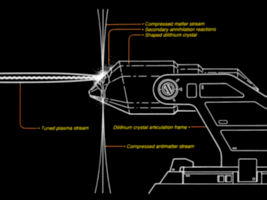
 Dilithium chamber of a Galaxy-class starship (TNG Technical Manual)
Dilithium chamber of a Galaxy-class starship (TNG Technical Manual)